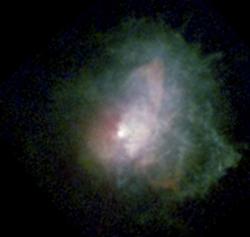Its brightness today is 500 times that of the Sun, and if it were in its place, its rim would reach outside the orbit of Saturn

Unfortunately, VY Canis Majoris is about to die. New images from the Hubble Space Telescope and the Keck Observatory in Hawaii have shown that large eruptions on its surface create loops, arcs and knots of material that scatter into space.
Initially it was believed that gas giants lose their material in a simple and spherical way, but this image shows that the process is far from clean and smooth. Every loop and arc that surrounds the star originates from huge eruptions occurring in the last thousand years. VY Canis Majoris is now losing 10 times more mass per time period than at normal times.
The origin of the eruptions are huge spots on the surface of the star, similar to the magnetic field, flames and cornelian mass (from the corona), only on a larger scale. VY Canis Majoris has a magnetic field large enough to produce giant outbursts.

7 תגובות
to stardust,
5000 light years is indeed 5000 years. These are 5000 years in which the light passes.
I really don't have the strength to explain it, but there's one thing I have to align with
5000 light years is really...but so really not 5000 years...don't think about thinking about confusing the two
For 1, it's likely already exploded. VY Canis Majoris is recognized as the largest known star. He is hyper huge. Because it takes time for light to reach us, and it is located 5,000 light years from us, so if it exploded 5000 years ago, we see it exploding right now, because the light from the explosion takes 5000 years to arrive. If we still see a star, it means it exploded more after 5000 years. We see it as it was 5000 years ago. It can't be that it hasn't exploded yet because we see that it is on the way to exploding, and this is how it would have looked about 5000 years ago.
It is amazing that when we talk about explosions on a cosmic scale they may last for a thousand years. Calling the death of a star a cosmic event sounds funny in such a case considering that the "event" takes place over such a long period of time. Think about where we - humanity - might be at the current rate of technological progress in a thousand years, as a time when some huge explosions will occur in the planet as a small part of the whole process of its death.
What makes it shine so brightly?
Just like that, he has been gone for a long time, maybe some fuzzy nebula, stardust is left of him.
I mean it exploded about 5000 years ago?